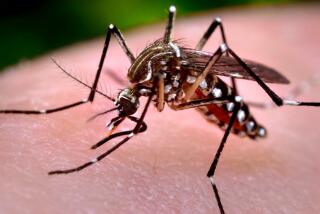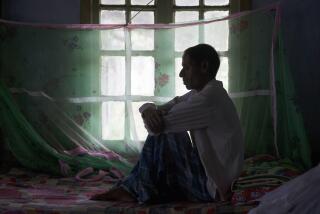AIDS: the Grim Battle
- Share via
The public health crisis that has been created by the AIDS epidemic is about to become the center of a budget battle in Los Angeles County. As it must. Only New York and San Francisco have graver problems.
The Los Angeles County supervisors are faced with new and grim evidence that they risk the entire population unless they end the neglect of the problem and focus resources--major resources--on slowing the spread of the disease and providing treatment centers for those infected.
There are some encouraging signs of an awakening sense of responsibility. A new administrator of the county AIDS program, Robert Saltzman, has been installed. And he has called for proposals for the development of a five-year plan to create a coordinated effort within Los Angeles County. But there is no assurance as yet that the supervisors will respond with adequate resources--resources measured in millions, not tens of thousands of dollars.
In the meantime, the Los Angeles County program is conspicuous for its inadequacy.
There is only one county-sponsored specialized outpatient AIDS clinic. There are virtually no alternatives to hospitals, no skilled-nursing facilities, no hospices, virtually no dental care. A 25-bed nursing facility is under construction. The Roman Catholic Archdiocese remains committed to opening a hospice, but has not yet found a site--let alone arranged the necessary funding. One experimental home-care program is in operation, but it is limited to 131 persons at a time when there are 2,722 reported cases in the county.
Furthermore, testing for the presence of the human immunodeficiency virus (HIV), believed to cause AIDS, is hard to come by. Expanded voluntary testing programs were cited as a priority at the recent national AIDS conference in Atlanta. The county operates only one testing program, located at the Hollywood Gay and Lesbian Community Services Center. The waiting time there for an appointment is seven weeks. Long Beach has a city testing center open two hours a week, supplemented by two other clinics that operate for a total of seven hours a week. There are no other free, anonymous, voluntary testing centers in the county. The county has under consideration three more test sites--in South-Central and East Los Angeles and in the San Fernando Valley--but the sites have not yet received final approval, and there is no likelihood of putting them into operation before the end of June.
Private physicians can arrange for tests. However, most private medical offices are not yet organized to assure confidentiality, and the training of doctors to do the critically important counseling of those testing positive is just getting under way. Also, the Los Angeles County Medical Assn. reports concern among doctors that health-insurance companies may gain access to private laboratory reports and cancel health coverage for individuals simply because they requested a test. The absence of confidentiality safeguards in medical offices makes all the more urgent an expansion of public testing sites.
Beyond the health services, the requisite public education program is missing. The county AIDS program office has a staff of five in its education unit to serve a population area of more than 8 million. The only known ways to slow the spread of the virus are abstinence or the use of condoms in sexual intercourse, and the use of sterile needles for intravenous drugs. Every day of delay perpetuates ignorance about protection strategies and increases the dimensions of the catastrophe that is taking shape.
At the present rate of increase, a million Americans will have AIDS in 1996--and that is a conservative estimate. For each person with AIDS, an estimated 50 more have the virus. It is still not clear how many with the virus will contract AIDS or AIDS-related condition (ARC). In the longest-term study to date, a sampling of persons seven years after they tested positive to the AIDS virus showed that 36% had AIDS and 38% had ARC. There is no known cure for AIDS.
Some experts are convinced that the very dimension of the problem, without equal in the history of medicine, may have retarded an effective response. Some dismissed it as an isolated problem for homosexuals, because the majority of the initial cases have infected them, and failed to recognize that it also affects heterosexuals. In fact, the epidemic will critically affect everyone, directly or indirectly, unless contained while the search for a cure continues.
AIDS is not a problem just for Los Angeles County. The urgent need for expanded services and education programs is evident in many other counties. Only in recent months has Orange County moved to appoint an AIDS coordinator, establish a county committee and launch an education program in the schools. Nor can counties do it on their own. Their efforts require additional state and federal funds.
But the credible response of San Francisco has demonstrated how much an effective city-county government can do. San Francisco currently spends 10 times more on AIDS than Los Angeles County does, even though San Francisco’s caseload is only 15% larger.
More to Read
Sign up for Essential California
The most important California stories and recommendations in your inbox every morning.
You may occasionally receive promotional content from the Los Angeles Times.










